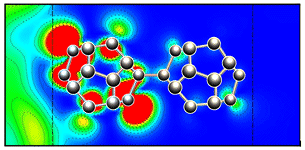
Computational Physics Laboratory (Morikawa Laboratory)
|
World of electrons and atoms through simulation
Computational physics is an academic field that uses numerical computation, that is, computer simulations on virtual models, to see how these models behave according to laws of nature instead of conducting experiments. Our laboratory conducts research to develop simulation programs based on quantum physics. Then we use these programs to understand the behaviors of electrons, atoms, molecules and materials in order to support the development of “nano to atomic scale manufacturing technologies”. Moreover, we strive to: (1) reveal physical phenomena of atoms, molecules and materials, which cannot be revealed only by means of experiments, (2) use this knowledge to design electronic devices, and (3) propose and develop the manufacturing processes for these devices.
Virtual microscope based on simulations
When simulations of numerous atoms and electrons can be executed at high speed, a virtual microscope, which is like “observing” real phenomena in nature, can be realized. However, a novel computational method based on a new concept as well as the development of fundamental theories and improved supercomputer performance is needed to realize such a “microscope of the future”. Hence, we are developing such a large-scale, high-speed computational method called the “order N method” based on our proprietary concept. In addition, we are also conducting research using accurate and high-speed computational methods to follow the temporal changes of the electron states, and the electron states of a system with many electrons so that when a simulation of a biological reaction where a great number of electrons and atoms are involved is realized, a microscope within a computer may be able to unlock the secrets of life.


Figure: Simulation of electron transport in a fullerene molecule
Electronic devices of the future realized through simulation
Atomic scale systems exhibit phenomena that cannot be seen in macroscopic systems such as electrical resistance that is not proportional to the length of a wire, and a circular current that flows around an atom. Our in-house first principle computational program based on the real-space finite-difference method can accurately predict the conductivity of the electrons through a nano-wire composed of a series of metal atoms or organic molecules. Moreover, our program can virtually observe the distribution of the electronic current. These simulation programs enable us to: (1) investigate the tunneling current flowing through a gap in a nano-scale structure, (2) analyze the leak current flowing on an insulating thin film in a semiconductor device, and (3) discover new functions of nanoscale structures. We expect that our simulation results will contribute to the development of high performance nano-electronic devices and spintronics devices as well as to help develop the next generation of ultra compact, ultra high speed, and low power consumption computers.

Figure: Magnetic field induced by current flowing through a spiral chain of gold atoms

565-0871, Japan
Department of Precision Science & Technology, Osaka University
E-mail:
www_admin[at]prec.eng.osaka-u.ac.jp